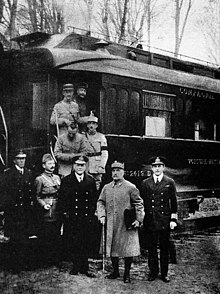
Back هدنة كومبين الأولى Arabic Kоmpyеn sülh sazişi (1918) Azerbaijani Першае камп’енскае перамір’е Byelorussian Компиенско примирие (1918) Bulgarian Armistici de Compiègne Catalan Příměří z Compiègne Czech Waffenstillstand von Compiègne (1918) German Ανακωχή της Κομπιέν (1918) Greek Armisticio del 11 de noviembre de 1918 Spanish Compiègne'i vaherahu Estonian

The Armistice of 11 November 1918 was the armistice signed at Le Francport near Compiègne that ended fighting on land, at sea, and in the air in World War I between the Entente and their last remaining opponent, Germany. Previous armistices had been agreed with Bulgaria, the Ottoman Empire and Austria-Hungary. It was concluded after the German government sent a message to American president Woodrow Wilson to negotiate terms on the basis of a recent speech of his and the earlier declared "Fourteen Points", which later became the basis of the German surrender at the Paris Peace Conference, which took place the following year.
Also known as the Armistice of Compiègne (French: Armistice de Compiègne, German: Waffenstillstand von Compiègne) from the place where it was officially signed at 5:45 a.m. by the Allied Supreme Commander, French Marshal Ferdinand Foch,[1] it came into force at 11:00 a.m. Central European Time (CET) on 11 November 1918 and marked a victory for the Entente and a defeat for Germany, although not formally a surrender.
The actual terms, which were largely written by Foch, included the cessation of hostilities on the Western Front, the withdrawal of German forces from west of the Rhine, Entente occupation of the Rhineland and bridgeheads further east, the preservation of infrastructure, the surrender of aircraft, warships, and military materiel, the release of Allied prisoners of war and interned civilians, eventual reparations, no release of German prisoners and no relaxation of the naval blockade of Germany. The armistice was extended three times while negotiations continued on a peace treaty. The Treaty of Versailles, which was officially signed on 28 June 1919, took effect on 10 January 1920.
Fighting continued up until 11 a.m. CET on 11 November 1918, with 2,738 men dying on the last day of the war.[2]
- ^ "Armistice: The End of World War I,1918". EyeWitness to History. 2004. Archived from the original on 26 November 2018. Retrieved 26 November 2018.
- ^ Persico 2005.